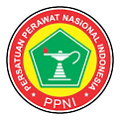Activity of Karamunting Leaf Extract (Rhodomyrtus tomentosa (Aiton) Hassk) as an Antibiofilm on Klebsiella pneumoniae
DOI:
https://doi.org/10.26630/jk.v16i2.4982Keywords:
Biofilm, Ethanol extract, InfectionsAbstract
Klebsiella pneumoniae can cause serious infections. The use of antibiotics is often an option in treating infections, but bacteria can adapt by forming biofilms. Therefore, the search for alternative antibiofilms from natural sources is important. One potential plant is karamunting leaves (Rhodomyrtus tomentosa (aiton) hassk). This study aims to describe the potential of the ethanol extract of karamunting leaf as an antibiofilm against Klebsiella pneumoniae. This study is an in vitro descriptive laboratory test. A thick ethanol extract of karamunting leaves was then prepared in three concentration variations: 62.5µg/mL, 125µg/mL, and 250µg/mL. The positive control used was meropenem, and the negative control used was DMSO. The parameter measured for the inhibition and eradication test was biofilm thickness, which was read using a 590nm Microplate reader. In this study, the percentage of inhibition in the three concentrations was 90.65% at a concentration of 250 µg/ml, 86.69% at a concentration of 125µg/ml, and 87.22% at a concentration of 62.5µg/ml. During the eradication test, the percentages obtained were -10.67% at a concentration of 250µg/ml, 3.58% at a concentration of 125µg/ml, and 68.23% at a concentration of 62.5µg/ml. The ethanolic extract of karamunting leaves demonstrates good biofilm inhibitory activity against Klebsiella pneumonia at all tested concentrations. At a concentration of 62.5µg/ml, the extract exhibits good biofilm eradication activity, while at 125µg/ml and in the positive control, it shows poor activity. Interestingly, at a concentration of 250µg/ml, the extract acts as a biofilm promoter, enhancing biofilm formation.
References
Abbas, R., Chakkour, M., Zein El Dine, H., Obaseki, E. F., Obeid, S. T., Jezzini, A., Ghssein, G., & Ezzeddine, Z. (2024). General overview of Klebsiella pneumonia: epidemiology and the role of siderophores in its pathogenicity. Biology, 13(2), 78. https://doi.org/10.3390/biology13020078
Abidah, H. Y. (2020). Uji aktivitas antibiofilm ekstrak daun murbei hitam (Morus nigra L.) terhadap biofilm Escherichia coli. [Thesis]. Malang: Universitas Islam Negeri Maulana Malik Ibrahim. http://etheses.uin-malang.ac.id/20599/
Aruperes, G. Y., Pangemanan, D. H. C., & Mintjelungan, C. N. (2021). Daya Hambat Ekstrak Daun Binahong (Anredera cordifolia Steenis) Terhadap Pertumbuhan Bakteri Streptococcus mutans. E-GiGi, 9(2), 250–255. https://doi.org/10.35790/eg.v9i2.34983
Biscevic-Tokic, J., Tokic, N., & Musanovic, A. (2013). Pneumonia as the most common lower respiratory tract infection. Medical Archives, 67(6), 442. http:// https://doi.org/10.5455/medarh.2013.67.442-445
Boakye, Y. D., Agyare, C., & Hensel, A. (2016). Anti-infective Properties and Time-Kill Kinetics of Phyllanthus muellerianus and its Major Constituent, Geraniin. Med chem (Los Angeles), 6, 095-104. https://doi.org/10.4172/2161-0444.1000332
Brackman, G., & Coenye, T. (2015). Quorum-sensing inhibitors as anti-biofilm agents. Current Pharmaceutical Design, 21(1), 5–11. https://doi.org/10.2174/1381612820666140905114627
Calabrese, E. J., & Mattson, M. P. (2017). How does hormesis impact biology, toxicology, and medicine? NPJ Aging and Mechanisms of Disease, 3(1), 13. https://doi.org/10.1038/s41514-017-0013-z
Cui, Y., Feng, X., Pan, L., Lin, Q., Wang, J., Zhen, S., Fan, Y., Chen, X., Zheng, Y., Mi, Y., & others. (2025). Antibiotic stewardship in hematological patients with Escherichia coli and Klebsiella pneumoniae bloodstream infections: evaluating short-course and carbapenem-sparing strategies. Annals of Clinical Microbiology and Antimicrobials, 24(1), 34. https://doi.org/10.1186/s12941-025-00801-y
Ebeledike, C., Ahmad, T., & Martin, S. D. (2021). Pediatric Pneumonia (Nursing). https://europepmc.org/article/NBK/nbk568682
Gorrie, C. L., Mirčeta, M., Wick, R. R., Judd, L. M., Lam, M. M. C., Gomi, R., Abbott, I. J., Thomson, N. R., Strugnell, R. A., Pratt, N. F., & others. (2022). Genomic dissection of Klebsiella pneumoniae infections in hospital patients reveals insights into an opportunistic pathogen. Nature Communications, 13(1), 3017. https://doi.org/10.1038/s41467-022-30717-6
Guerra, M. E. S., Destro, G., Vieira, B., Lima, A. S., Ferraz, L. F. C., Hakansson, A. P., Darrieux, M., & Converso, T. R. (2022). Klebsiella pneumoniae biofilms and their role in disease pathogenesis. Frontiers in Cellular and Infection Microbiology, 12, 877995. https://doi.org/10.3389/fcimb.2022.877995
Hasibuan, R., & others. (2017). Kajian Kandungan Fitokimia Dari Ekstrak Haramonting (Rhodomytus tomentosa) Sebagai Obat Herbal. Seminar Nasional Multidisiplin Ilmu. https://doi.org/10.31227/osf.io/743yg_v1
Hetta, H. F., Ramadan, Y. N., Rashed, Z. I., Alharbi, A. A., Alsharef, S., Alkindy, T. T., Alkhamali, A., Albalawi, A. S., Battah, B., & Donadu, M. G. (2024). Quorum-sensing inhibitors: an alternative strategy to win the battle against multidrug-resistant (MDR) bacteria. Molecules, 29(15), 3466. https://doi.org/10.3390/molecules29153466
Karepu, M. G., Suryanto, E., & Momuat, L. I. (2020). Komposisi kimia dan aktivitas antioksidan dari paring kelapa (Cocos nucifera). Chemistry Progress, 13(1). https://doi.org/10.35799/cp.13.1.2020.29604
Khotimah, A. R. H. (2020). Uji Aktivitas Ekstrak Daun Murbei Hitam (Morus nigra L.) sebagai Antibiofilm Klebsiella Pneumoniae. [Thesis]. Malang: Universitas Islam Negeri Maulana Malik Ibrahim. http://etheses.uin-malang.ac.id/21609/
Lukito, J. I. (2023). Tren penggunaan antibiotik. Cermin Dunia Kedokteran, 50(12), 673–680. https://doi.org/10.55175/cdk.v50i12.1049
Mathlouthi, A., Pennacchietti, E., & De, B. D. (2018). Effect of temperature, pH, and plasmids on in vitro biofilm formation in Escherichia coli. Acta Naturae (Русскоязычная Версия), 10(4 (39)), 129–132. https://doi.org/10.32607/20758251-2018-10-4-129-132
Naves, P., Del Prado, G., Huelves, L., Gracia, M., Ruiz, V., Blanco, J., Rodr’iguez-Cerrato, V., Ponte, M. C., & Soriano, F. (2008). Measurement of biofilm formation by clinical isolates of Escherichia coli is method-dependent. Journal of Applied Microbiology, 105(2), 585–590. https://doi.org/10.1111/j.1365-2672.2008.03791.x
Prince, S. E., Dominger, K. A., Cunha, B. A., & Klein, N. C. (1997). Klebsiella pneumoniae pneumonia. Heart & Lung, 26(5), 413–417. https://doi.org/10.1016/S0147-9563(97)90028-5
Rahmi, M., & Putri, D. H. (2020). Aktivitas antimikroba DMSO sebagai pelarut ekstrak alami. Serambi Biologi, 5(2), 56–58.
Riwu, K. H. P., Effendi, M. H., Rantam, F. A., Khairullah, A. R., & Widodo, A. (2022). A review: Virulence factors of Klebsiella pneumonia as emerging infection on the food chain. Veterinary World, 15(9), 2172. https://doi.org/10.14202/vetworld.2022.2172-2179
Sabrina, T., Kamaluddin, M. T., & others. (2021). The Effectiveness of Karamunting Leaf's Fraction (Rhodomyrtus tomentosa (Aiton) Hassk) as Antimicrobials in Carbapenemase-Resistant Klebsiella pneumonia. Sriwijaya Journal of Medicine, 4(1), 1–8. https://doi.org/10.32539/sjm.v4i1.225
Saising, J., Ongsakul, M., & Voravuthikunchai, S. P. (2011). Rhodomyrtus tomentosa (Aiton) Hassk. Ethanol extract and rhodomyrtone: a potential strategy for the treatment of biofilm-forming staphylococci. Journal of Medical Microbiology, 60(12), 1793–1800. https://doi.org/10.1099/jmm.0.033092-0
Salim, A., Kristanto, D. F., Subianto, F., Sundah, J. E., Jamaica, P. A., Angelika, T., Maulida, N. F., & others. (2021). Phytochemical screening and therapeutic effects of Binahong (Anredera cordifolia (Ten.) Steenis) Leaves. Indonesian Journal of Life Sciences, 43–55. https://doi.org/10.54250/ijls.v3i2.125
Sari, I., Choesrina, R., & Hazar, S. (2017). Uji Aktivitas Ekstrak Etanol Daun Karamunting (Rhodomyrtus tomentosa (Aiton) Hassk.) terhadap Penyembuhan Luka Bakar Derajat II pada Kulit Punggung Tikus Putih Jantan Galur Wistar. SPeSIA, 3, 108–116.
Sasadara, M. M. V., & Wiranata, I. G. (2022). Pengaruh pelarut dan metode ekstraksi terhadap kandungan metabolit sekunder dan nilai Ic50 ekstrak umbi bit (Beta vulgaris L.). Usadha, 2(1), 7–13. https://doi.org/10.36733/usadha.v2i1.5277
Serrano, J., Puupponen-Pimiä, R., Dauer, A., Aura, A.-M., & Saura-Calixto, F. (2009). Tannins: current knowledge of food sources, intake, bioavailability, and biological effects. Molecular Nutrition & Food Research, 53(S2), S310--S329. https://doi.org/10.1002/mnfr.200900039
Shadkam, S., Goli, H. R., Mirzaei, B., Gholami, M., & Ahanjan, M. (2021). Correlation between antimicrobial resistance and biofilm formation capability among Klebsiella pneumoniae strains isolated from hospitalized patients in Iran. Annals of Clinical Microbiology and Antimicrobials, 20, 1–7. https://doi.org/10.1186/s12941-021-00418-x
Shenkutie, A. M., Yao, M. Z., Siu, G. K., Wong, B. K. C., & Leung, P. H. (2020). Biofilm-induced antibiotic resistance in clinical Acinetobacter baumannii isolates. Antibiotics, 9(11), 817. https://doi.org/10.3390/antibiotics9110817
Surgers, L., Boyd, A., Girard, P.-M., Arlet, G., & Decré, D. (2019). Biofilm formation by ESBL-producing strains of Escherichia coli and Klebsiella pneumoniae. International Journal of Medical Microbiology, 309(1), 13–18. https://doi.org/10.1016/j.ijmm.2018.10.008
Taufiq, M. M. J., & Darah, I. (2020). Antibacterial and antibiofilm activities of crude extract of Lasiodiplodia pseudotheobromae IBRL OS-64 against the foodborne bacterium, Yersinia enterocolitica. Journal of Pharmaceutical Research International, 32(14), 87–102. https://doi.org/10.9734/jpri/2020/v32i1430609
Vestby, L. K., Grønseth, T., Simm, R., & Nesse, L. L. (2020). Bacterial biofilm and its role in the pathogenesis of disease. Antibiotics, 9(2), 59. https://doi.org/10.1016/j.ijmm.2018.11.002
Walraven, C. J., Bernardo, S. M., Wiederhold, N. P., & Lee, S. A. (2013). Paradoxical antifungal activity and structural observations in biofilms formed by echinocandin-resistant Candida albicans clinical isolates. Sabouraudia, 52(2), 131–139. https://doi.org/10.1093/mmy/myt007
Yulianti, W., Ayuningtyas, G., Martini, R., & Resmeiliana, I. (2020). Pengaruh metode ekstraksi dan polaritas pelarut terhadap kadar fenolik total daun kersen (muntingia calabura l). Jurnal Sains Terapan: Wahana Informasi Dan Alih Teknologi Pertanian, 10(2), 41–49. https://doi.org/10.29244/jstsv.10.2.41-49
Zhang, W., He, M., Kong, N., Niu, Y., Li, A., & Yan, Y. (2024). Study on the inhibition activity and mechanism of Tanreqing against Klebsiella pneumoniae biofilm formation in vitro and in vivo. Frontiers in Cellular and Infection Microbiology, 14, 1368450. https://doi.org/10.3389/fcimb.2024.1368450
Downloads
Published
Issue
Section
License
Copyright (c) 2025 Tia Sabrina, Ricardo Simanjuntak, Erizka Rivani, Rima Zanaria, Evi Lusiana

This work is licensed under a Creative Commons Attribution-ShareAlike 4.0 International License.
Authors who publish in this journal agree to the following terms:
- Authors retain copyright and grant the journal right of first publication with the work simultaneously licensed under a Creative Commons Attribution License (CC BY-SA 4.0) that allows others to share the work with an acknowledgment of the work's authorship and initial publication in this journal.
- Authors can enter into separate, additional contractual arrangements for the non-exclusive distribution of the journal's published version of the work (e.g., post it to an institutional repository or publish it in a book), with an acknowledgment of its initial publication in this journal.
- Authors are permitted and encouraged to post their work online (e.g., in institutional repositories or on their website) prior to and during the submission process, as this can lead to productive exchanges and earlier and greater citations of published work.











